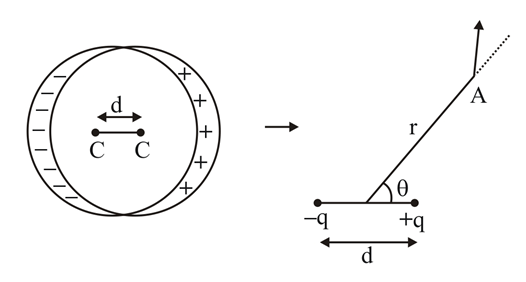- Tardigrade
- Question
- Physics
- Consider two spheres of the same radius R having uniformly distributed volume charge density of same magnitude but opposite sign (.+Žü and -Žü .. The spheres overlap such that the vector joining the centres of the negative sphere to that of the positive sphere is overset arrow d(d ll R). The magnitude of the electric field at a point outside the spheres at a distance r in a direction making an angle ╬Ė with overset arrow d is found to be (Žü /a ((ŽĄ )0))((R3 d/r3))ŌłÜb (cos)2 ╬Ė + 1. The value of (.a+b.) is (Distance r is measured with respect to the mid point of the line joining the centers of the two spheres.)
Q. Consider two spheres of the same radius $R$ having uniformly distributed volume charge density of same magnitude but opposite sign $\left(\right.+\rho $ and $-\rho \left..$ The spheres overlap such that the vector joining the centres of the negative sphere to that of the positive sphere is $\overset{ \rightarrow }{d}\left(d \ll R\right).$ The magnitude of the electric field at a point outside the spheres at a distance $r$ in a direction making an angle $\theta $ with $\overset{ \rightarrow }{d}$ is found to be $\frac{\rho }{a \left(\left(\epsilon \right)_{0}\right)}\left(\frac{R^{3} d}{r^{3}}\right)\sqrt{b \left(cos\right)^{2} \theta + 1}.$ The value of $\left(\right.a+b\left.\right)$ is (Distance $r$ is measured with respect to the mid point of the line joining the centers of the two spheres.)
Solution:
For writing field at an outside point, we can consider the charge on each sphere to be located at respective centre. Thus we have a dipole of dipole moment
$\overset{ \rightarrow }{p}=q\overset{ \rightarrow }{d}$
Where $q=\rho \cdot \frac{4}{3}\pi R^{3}$
Field at $A$
$E=\frac{p}{4 \pi \epsilon _{0} r^{3}}\sqrt{3 cos^{2} \theta + 1}$
$=\frac{\rho }{3 \epsilon _{0}}\frac{R^{3} d}{r^{3}}\sqrt{3 cos^{2} \theta + 1}$

Questions from NTA Abhyas 2022
5. The force of repulsion between two point charges is $F$ , when these are at distance $0.5 \, m$ apart. Now the point charges are replaced by non conducting spheres of radii $5 \, cm$ each having the same charge as that of the respective point charges. The distance between their centres is again kept $0.5m.$ Then the force of repulsion will
Electrostatic Potential and Capacitance
Physics Most Viewed Questions
1. If $E$ and $G$ respectively denote energy and gravitational constant, then $\frac{ E }{ G }$ has the dimensions of:
NEET 2021
Physical World, Units and Measurements
2. The de Broglie wavelength of an electron moving with kinetic energy of $144 \,eV$ is nearly
NEET 2020
Dual Nature of Radiation and Matter
3. A car starts from rest and accelerates at $5\, m / s ^{2}$ At $t=4\, s$, a ball is dropped out of a window by a person sitting in the car. What is the velocity and acceleration of the ball at $t =6\, s$ ? (Take $\left. g =10\, m / s ^{2}\right)$
NEET 2021
Motion in a Straight Line
Latest Updates
- JEE Main 2023 February 25th Shift 1 Morning
- JEE Main 2023 February 25th Shift 2 Evening
- JEE Main 2023 January 31st Shift 1 Morning
- JEE Main 2023 January 31st Shift 2 Evening
- JEE Main 2023 January 30th Shift 1 Morning
- JEE Main 2023 January 30th Shift 2 Evening
- JEE Main 2023 January 25th Shift 1 Morning
- JEE Main 2023 January 25th Shift 2 Evening
- JEE Main 2023 January 24th Shift 1 Morning
- JEE Main 2023 January 24th Shift 2 Evening
- JEE Main 2023 February 1st Shift 1 Morning
- JEE Main 2023 February 1st Shift 2 Evening
- JEE Main 2022 July 25th Shift 1 Morning
- JEE Main 2022 July 25th Shift 2 Evening
- JEE Main 2022 July 26th Shift 1 Morning
- JEE Main 2022 July 28th Shift 1 Morning
- JEE Advanced 2022 Paper 2
- JEE Advanced 2022 Paper 1
- JEE Advanced 2021 Paper 2
- JEE Advanced 2021 Paper 1
- JEE Advanced 2020 Paper 2
- JEE Advanced 2020 Paper 1
- NEET 2022 Physics Answer Key
- NEET 2022 Chemistry Answer Key
- NEET 2022 Botany Biology Answer Key
- NEET 2022 Zoology Biology Answer Key
- NEET Rank Predictor 2023
